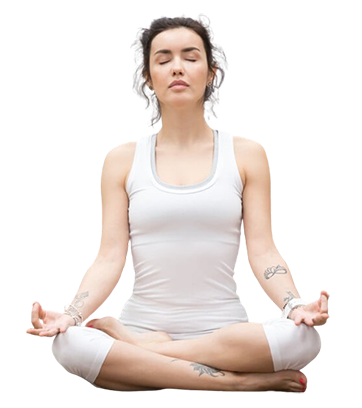On This Page
Bhastrika Pranayama – Introduction, Procedure, and Benefits
Introduction
In Sanskrit Bhastrika means bellows. A characteristic feature of Bhastrika is the rapid succession of forcible expulsion. Just as a blacksmith blows his bellows rapidly, so also you should move your breath rapidly. Bhastrika is a powerful exercise. A combination of Kapal Bhati and Ujjayi makes up Bhastrika. Practice Kapal Bhati and Ujjayi to start with. Then You will find it very easy to do Bhastrika.
For Bhastrika Pranayama, one can sit in Padmasana. Keep the Sharira (body), Griva (neck), and Shira (head) erect. Close your mouth. Next, inhale and exhale quickly ten times like the bellows of the Lohar (blacksmith). Constantly dilate and contract. When you practice this Pranayama, a hissing sound is produced. The practitioner should start with rapid expulsions of breath following one another in rapid succession. When the required number of expulsions, say ten for a round is finished, the final expulsion is followed by the deepest possible inhalation. The breath is suspended if it could be done with comfort.

Procedure of Bhastrika Pranayama
Four stages are involved in Bhastrika Pranayama:-
Stage 1: In stage one, Nasa Gata Randhra (nostrils) are kept open throughout.
Stage 2: In stage two, both Nasa Gata Randhra (nostril) is partial;y kept closed throughout.
Stage 3: In this stage, Bhastrika is done through an alternate nostril with an interspersion of Ujjayi breaths.
Stage 4: In stage three one cycle of Bhastrika blasts is done through the right nostril, the other from the left. In this stage the in- and our blasts are done through the alternate nostrils, that is, if the in-breath is done from the right, then the out-breath is from the left, and then the other way round. Four or five such blasts form one half-cycle. The other one starts with an in-breath from the left and is followed by an out-breath from the right, with an equal number of blasts. These two make one cycle of Stage IV.

Have A Health Issue?
Consult Online
- Dr. Sahil Gupta (B.A.M.S., M.H.A.)
Ayurvedic Allergy Specialist
CEO & Founder of IAFA®
Benefits of Bhastrika Pranayama
- Bhastrika relieves inflammation of the throat, increases gastric fire, destroys phlegm, removes diseases of the nose and chest and eradicates asthma, consumption, etc.
- It gives a good appetite. It breaks the three Granthis or knots viz. Brahma Granthi, Vishnu Granthi and Rudra Granthi.
- It destroys phlegm which is the bolt or obstacle to the door at the mouth of Brahma Nadi (Sushumna). It enables one to know the Kundalini.
- It removes all diseases which arise from excess wind, bile and phlegm.
- It gives warmth to the body. When you have no sufficient warm clothing in a cool region to protect yourself from cold, practice this Pranayama and you will get sufficient warmth in the body quickly.
- It purifies the Nadis considerably. It is the most beneficial of all Kumbhakas. Bhastrika Kumbhaka should be specially practiced as it enables the Prana to break through the three Granthis or knots that are firmly located in the Sushumna.
- It awakens the Kundalini quickly. The practitioner will never suffer from any disease. He will always be healthy.
Bhastrika Pranayama – According to Classical Texts
Gherand Samhita, by commentator Acharya Shri Nivaas Sharma, Pancham Updesh, 74
भस्त्रिका कुम्भक:
भस्त्रेव लौहकाराणां यथाक्रमेण सम्भ्रमेत्।
ततो वायुञ्च नासाभ्यामुभाभ्यांचालयेच्छनै: ।।
लौहकार् (लोहार) की भस्त्रा (धौकनी अथवा भाथी ) के द्वारा जिस प्रकार क्रमश: वायु का आकर्षण किया जाता है, उसी प्रकार नासापुटों से वायु का आकर्षण करने के पश्चात उदर मध्य में धीरे-धीरे उसका परिचालन करना चाहिये।
(The way the air is attracted by the Bhastra (Dhaukni or Bhathi) of the ironwork (blacksmith), in the same way, after attracting the air from the nostrils, it should be operated slowly in the abdominal middle.)
Procedure of Bhastrika Pranayama – According to Classical Texts
Gherand Samhita, by commentator Acharya Shri Nivaas Sharma, Pancham Updesh, 75, 76
एवं विशतिवारञ्च कृत्वा कुर्याच्च कुम्भकम्।
तदन्ते चालयेद्वायुं पूर्वोक्तञ्च यथाविधि।।
त्रिवारं साधयेदेन॑ भस्त्रिकाकुम्भकं सुधी: ।
न च रोग॑ न च क्लेशमारोग्यञ्च दिने दिने।।
उपर्युक्त विधि से बीस बार वायु को परिचालित करने के उपरान्त कुम्भक योग का अनुष्ठान करतें हुये उस परिचालित वायु को धारण करते हुये पुन: उस धारित वायु की पूर्वकथित विधि द्वारा भीतर ही परिचालित करने के पश्चात् अन्त में भस्त्रिका -विधि का आश्रयण करते हुये नासाछिद्रों के माध्यम से उसे बाहर निकाल देना चाहिये। तात्पर्य यह है कि जिस प्रकार भस्त्रिका (लौहकार की भाथी ) में भरी हुई वायु धीरे- धीरे बाहर निकलती है, उसी प्रकार साधक को भी शनै:- शनै: ही वायु को बाहर निकालना चाहिये। इसे ही भस्त्रिका कुम्भक कहा जाता है। इसका यथाविधि तीन बार आचरण करने पर साधक के शरीर में किसी प्रकार की व्याधि उत्पन नहीं होती।
(After circulating the air twenty times by the above method, while performing the ritual of Kumbhaka Yoga, holding that circulating air and again circulating it inside by the aforesaid method of that held air, in the end, by taking shelter of Bhastrika method, the nostrils It should be thrown out through the medium. The meaning is that just as the air filled in the Bhastrika (iron’s sister-in-law) slowly comes out, similarly the seeker should also expel the air slowly. This is called Bhastrika Kumbhak. If it is practiced thrice as per the procedure, there is no disease of any kind in the body of the seeker.)
Hath Yoga Pradipika, by Swami Shri Dwarika Das Shastri, Dwitiya Updesha, 60
सम्यक् पद्मासन बदध्वा समग्रीवोदर सुधीः
मुखें संयम्य यत्नेन, घ्राणं ज्राणेन रेचयेत।।
साधक इस पद्मासन को विधिपूर्वक लगा कर, अपने शरीर को ग्रीवा से उदर तक समतल (सीधा) रखते हुए, मुख को संयत (बंद) कर शरीरस्थ प्राण वायु को नासिका के एक छिद्र से बाहर निकाले।
(Sadhak (Practitioner) by applying this Padmasana methodically, keeping his body level (upright) from the neck to the abdomen, keeping the mouth restrained (closed) and expelling the Prana Vayu from the body through a nostril.)
Hath Yoga Pradipika, by Swami Shri Dwarika Das Shastri, Dwitiya Updesha, 61
यथा लगति हत्कण्ठे कपालावधि सस्वनम्।
वेगें पूरयेच्चापि हत्पद्मावधि मारुतम्।।
अब उसके रेचेन (बाहर निकालने) की विधि बता रहे हैं- साधक इस वायु का इस प्रकार रेचन करे कि वह वायु हृदय एवं कण्ठ में शब्द करती हुई कपाल में लगे | पुनः उसी प्रकार वेगपूर्वक उस वायु को हृदय से कपालपर्यन्त अंदर खींचे।
(Now we are telling the method of its catharsis – Sadhak should cathartic this air in such a way that it engages in the cranium while uttering words in the heart and throat. Again, in the same way, with the same velocity, draw that air from the heart till the cranium.)
Hath Yoga Pradipika, by Swami Shri Dwarika Das Shastri, Dwitiya Updesha, 62
पुनर्विरिचयेत् तद्वत् पूरयेच्च पुनः पुनः ।
यथेव लोहकारेण भस्त्रा वेगेन चाल्यते।।
साधक इस क्रिया को बार बार इसी विधि से उसी प्रकार करता रहे, जैसे किसी लोहकारँ की भस्त्रा वायु का वेगपूर्वक आदान प्रदान किया करती।
(Practitioner continued to do this action again and again with the same method, as if the Bhasra of an ironsmith would exchange air with speed.)
Hath Yoga Pradipika, by Swami Shri Dwarika Das Shastri, Dwitiya Updesha, 63
तथेव स्व शरीरस्थं चालयेत पवन॑ धिया |
यदा श्रमो भवेद देहे तदा सूर्येण पूरयेत ||
उसी प्रकार बुद्धिमान, साधक को भी स्वशरीरस्थ वायु का सञ्चालन करते रहना चाहिए |
(In the same way, the wise, practitioner should also keep the air in his body moving.)
Hath Yoga Pradipika, by Swami Shri Dwarika Das Shastri, Dwitiya Updesha, 64
यथोदर॑ भवेत् पूर्णम् अनिलेन तथा लघु।
धारयेन्नासिकां मध्यतर्जनीभ्यां विना दृढम्।।
जिससे उदर में वायुपूर्ति जितनी शीघ्र हो जाय, साधक को उस सूर्यनाडी का ऐसा ही उपयोग करना चाहिये। तब साधक अपनी नासिका को मध्यमा एवं तरजनी अंगुलियों के विना केवल अंगुष्ठ , अनामिका एवं कनिष्टिका अँगुलियों को दबा कर उस वायु को अपने उदर में रोके । अर्थात् कुम्भक प्राणायाम से धारण करे।
(So that as soon as there is air supply in the abdomen, the seeker should use that Surya Nadi in the same way. Then the seeker should hold that air in his abdomen by pressing only his thumb, ring finger and little finger without the middle and index fingers of his nostrils. That is, wear Kumbhak with Pranayama.)
Hath Yoga Pradipika, by Swami Shri Dwarika Das Shastri, Dwitiya Updesha, 65
विधिवत् कुम्भक॑ कृत्वा रेचयेदिडयानिलम्।
त्रिदोष नाशकं चैव शरीराग्निविवर्धनम्।।
भस्त्रिका का फल – बन्धपूर्वक कुम्भक क्रिया कर इडा (चन्द्र) नाड़ी से प्राण वायु का रेचन करे । प्राणायाम की इस पद्धति से वात, पित्त एवं श्लेष्म से जनित रोगों का नाश होता है, तथा पाचकाग्नि का दीपन होता है। शास्त्रकारों ने भस्त्रा कुम्भक पद्धति की द्विविध परिपाटी बतायी है। उसके विषय में साधक को गुरु के साक्षात् उपदेश की आवश्यकता होती है। पुस्तक ज्ञान से कार्यसिद्धि में पूर्ण सफलता नहीं मिलती।
The fruit of Bhastrika – By performing Kumbhak action with bondage, purifies the air of life from the Ida (moon) nadi. By this method of Pranayama, diseases caused by Vata, Pitta and mucus are destroyed, and the digestive fire is lit. Shastra writers have given two-fold practice of Bhastra Kumbhaka method. The seeker needs the direct instruction of the Guru regarding that. Book knowledge does not lead to complete success in accomplishment.
Bhastrika Pranayama in Classical Literature

Was this Page Helpful?
Read More Articles

Bhastrika Pranayama
In Sanskrit Bhastrika means bellows. A characteristic feature of Bhastrika is the…





